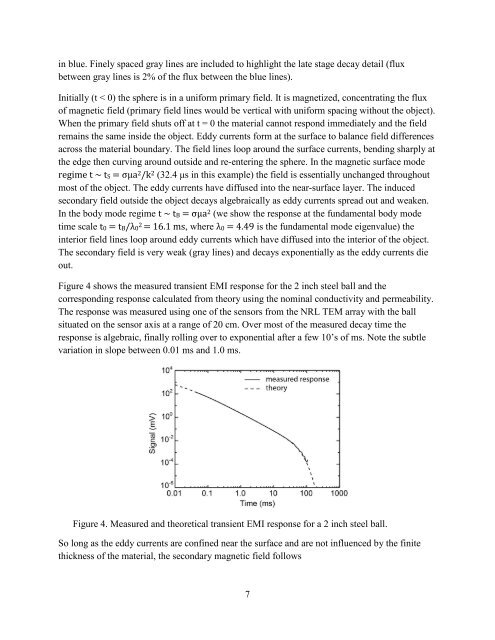Final Report - Strategic Environmental Research and Development ...
Final Report - Strategic Environmental Research and Development ...
Final Report - Strategic Environmental Research and Development ...
- No tags were found...
Create successful ePaper yourself
Turn your PDF publications into a flip-book with our unique Google optimized e-Paper software.
in blue. Finely spaced gray lines are included to highlight the late stage decay detail (fluxbetween gray lines is 2% of the flux between the blue lines).Initially (t < 0) the sphere is in a uniform primary field. It is magnetized, concentrating the fluxof magnetic field (primary field lines would be vertical with uniform spacing without the object).When the primary field shuts off at t = 0 the material cannot respond immediately <strong>and</strong> the fieldremains the same inside the object. Eddy currents form at the surface to balance field differencesacross the material boundary. The field lines loop around the surface currents, bending sharply atthe edge then curving around outside <strong>and</strong> re-entering the sphere. In the magnetic surface moderegime t ~ tS = σμa 2 /k 2 (32.4 μs in this example) the field is essentially unchanged throughoutmost of the object. The eddy currents have diffused into the near-surface layer. The inducedsecondary field outside the object decays algebraically as eddy currents spread out <strong>and</strong> weaken.In the body mode regime t ~ tB = σμa 2 (we show the response at the fundamental body modetime scale t0 = tB/λ0 2 = 16.1 ms, where λ0 = 4.49 is the fundamental mode eigenvalue) theinterior field lines loop around eddy currents which have diffused into the interior of the object.The secondary field is very weak (gray lines) <strong>and</strong> decays exponentially as the eddy currents dieout.Figure 4 shows the measured transient EMI response for the 2 inch steel ball <strong>and</strong> thecorresponding response calculated from theory using the nominal conductivity <strong>and</strong> permeability.The response was measured using one of the sensors from the NRL TEM array with the ballsituated on the sensor axis at a range of 20 cm. Over most of the measured decay time theresponse is algebraic, finally rolling over to exponential after a few 10’s of ms. Note the subtlevariation in slope between 0.01 ms <strong>and</strong> 1.0 ms.Figure 4. Measured <strong>and</strong> theoretical transient EMI response for a 2 inch steel ball.So long as the eddy currents are confined near the surface <strong>and</strong> are not influenced by the finitethickness of the material, the secondary magnetic field follows7
















